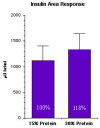Metabolic response of people with type 2 diabetes to a high protein diet
- PMID: 15507157
- PMCID: PMC524031
- DOI: 10.1186/1743-7075-1-6
Metabolic response of people with type 2 diabetes to a high protein diet
Abstract
Background: One of the major interests in our laboratory has been to develop a scientific framework for dietary advice for patients with diabetes. Knowledge regarding the metabolic consequences and potential effects on health of protein in people with type 2 diabetes has been a particular interest.
Results: We recently have completed a study in which dietary protein was increased from 15% to 30% of total food energy. The carbohydrate content was decreased from 55% to 40%, i.e. dietary protein replaced part of the carbohydrate. This resulted in a significant decrease in total glycohemoglobin, a decrease in postprandial glucose concentrations and a modest increase in insulin concentration. Renal function was unchanged. Currently we also are determining the metabolic response to a diet in which the carbohydrate content is further decreased to 20% of total food energy. The %tGHb decrease was even more dramatic than with the 40% carbohydrate diet.
Conclusion: From these data we conclude that increasing the protein content of the diet at the expense of carbohydrate can reduce the 24-hour integrated plasma glucose concentration, at least over a 5-week period of time. The reduction was similar to that of oral agents. Renal function was not affected significantly. Thus, increasing the protein content of the diet with a corresponding decrease in the carbohydrate content potentially is a patient empowering way of reducing the hyperglycemia present with type 2 diabetes mellitus, independent of the use of pharmaceutical agents.
Figures








References
-
- Janney NW. The metabolic relationship of the proteins to glucose. J Biol Chem. 1915;20:321–350.
-
- MacLean H. Modern Methods in the Diagnosis and Treatment of Glycosuria and Diabetes. 2nd edition. London, Constable & Co. Ltd.; 1924. pp. 1–52.
-
- Joslin EP. Diabetic Manual of the Doctor and Patient. Philadelphia, Lea & Febinger; 1945.
-
- Nuttall FQ, Mooradian AD, Gannon MC, Billington CJ, Krezowski PA. Effect of protein ingestion on the glucose and insulin response to a standardized oral glucose load. Diabetes Care. 1984;7:465–470. - PubMed
Publication types
LinkOut - more resources
Full Text Sources
Other Literature Sources

